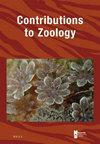多基因系统发育揭示了Sarika陆地蜗牛属(Eupulmonata: Ariophantidae)的肋壳形态,并描述了来自泰国和缅甸的两个新种
IF 2.2
2区 生物学
Q1 ZOOLOGY
引用次数: 1
摘要
种类陆地蜗牛属广泛分布在整个东南亚大陆。这个属通常通过光滑和抛光的外壳来识别。然而,我们发现有4种具有肋状壳表面的物种(S. siamensis, S. theodori, S. costabilis sp. nov和S. costata sp. nov)表现出与Sarika s.s相似的生殖特征,因此建议在系统分类中进行重排。在这里,我们将这四种肋壳物种与Sarika s.s.结合形态学和分子方法进行物种划分,后者基于线粒体(coi和16S)和核(28S)标记。我们的分子系统发育证实了Sarika属的单系性,包括光滑和肋壳形态,这在统计上得到了很好的支持。在诊断形态解剖特征方面,陆地蜗牛属的肋壳形态也被很好地定义,可以分为两个种群。costata种群中只有S. costata sp. nov.,而S. siamensis种群中有S. siamensis、S. theodori和S. costabilis sp. nov.,这些发现为Ariophantidae的系统划分提供了坚实的基础。本文章由计算机程序翻译,如有差异,请以英文原文为准。
Multigene phylogeny reveals the ribbed shell morphotypes in the land snail genus Sarika (Eupulmonata: Ariophantidae), with description of two new species from Thailand and Myanmar
The speciose land snail genus Sarika is widely distributed throughout mainland Southeast Asia. This genus is generally recognized by a smooth and polished shell. However, we recognize four species with a ribbed shell surface (S. siamensis, S. theodori, S. costabilis sp. nov., and S. costata sp. nov.) exhibiting genital characters similar to those of Sarika s.s. and so a rearrangement in the systematics of the genus is suggested. Here, we analysed these four ribbed shell species together with Sarika s.s. by a combined morphological and molecular approach to species delineation, the latter based on both mitochondrial (coi and 16S) and nuclear (28S) markers. Our molecular phylogeny affirms the monophyly of the genus Sarika including both smooth and ribbed shell morphotypes that is statistically well supported. The ribbed shell morphotype in the land snail genus Sarika is also well defined in terms of diagnostic morpho-anatomical characters that can be divided into two species groups. The S. costata species group consists of only one species, S. costata sp. nov., while the S. siamensis species group comprises S. siamensis, S. theodori and S. costabilis sp. nov. These findings provide a solid basis for the systematics of family Ariophantidae.
求助全文
通过发布文献求助,成功后即可免费获取论文全文。
去求助
来源期刊

Contributions to Zoology
生物-动物学
CiteScore
4.00
自引率
4.50%
发文量
16
审稿时长
>12 weeks
期刊介绍:
Contributions to Zoology solicits high-quality papers in all systematics-related branches of comparative zoology (including paleozoology). Preference will be given to manuscripts dealing with conceptual issues and to integrative papers (e.g., ecology and biodiversity, morphology and phylogeny and character state evolution, phylogeny and historical biogeography, systematics and bioinformatics, bioinformatics and biodiversity, habitat disturbance and biogeography, etc.). Reviews and alpha-taxonomic contributions are considered for publication, but acceptance will depend on their high quality and exceptional nature.
 求助内容:
求助内容: 应助结果提醒方式:
应助结果提醒方式:


